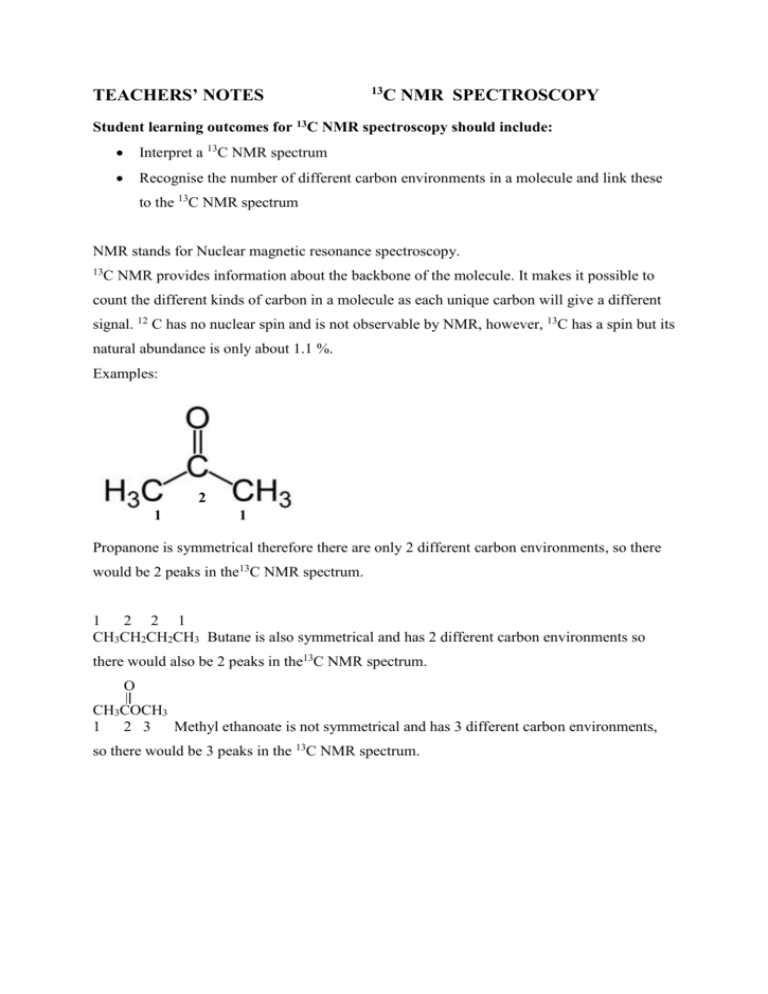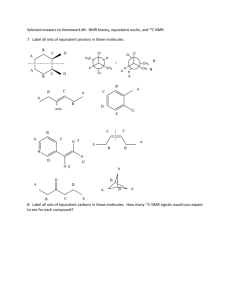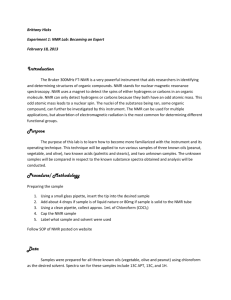13C NMR Spectroscopy: Teacher's Notes
advertisement

TEACHERS’ NOTES 13 C NMR SPECTROSCOPY Student learning outcomes for 13C NMR spectroscopy should include: Interpret a 13C NMR spectrum Recognise the number of different carbon environments in a molecule and link these to the 13C NMR spectrum NMR stands for Nuclear magnetic resonance spectroscopy. 13 C NMR provides information about the backbone of the molecule. It makes it possible to count the different kinds of carbon in a molecule as each unique carbon will give a different signal. 12 C has no nuclear spin and is not observable by NMR, however, 13C has a spin but its natural abundance is only about 1.1 %. Examples: 2 1 1 Propanone is symmetrical therefore there are only 2 different carbon environments, so there would be 2 peaks in the13C NMR spectrum. 1 2 2 1 CH3CH2CH2CH3 Butane is also symmetrical and has 2 different carbon environments so there would also be 2 peaks in the13C NMR spectrum. O CH3COCH3 1 2 3 Methyl ethanoate is not symmetrical and has 3 different carbon environments, so there would be 3 peaks in the 13C NMR spectrum. 13 C NMR makes it possible to count the different kinds of carbons present in a molecule. Information can also be gained about the chemical environment of each carbon by observing its chemical shift. Below is a chart with different types of carbons and their relative chemical shift δ, expressed in parts per million (ppm) by frequency as it is calculated by: δ = difference between a resonance frequency and that of a reference substance (TMS) operating frequency of the spectrometer TMS= tetramethylsilane used to calibrate chemical shift in 13C NMR spectroscopy 13 C NMR Chemical shift correlations (these values may differ slightly depending on the source used) Type of carbon Chemical shift (δ) Type of carbon Chemical shift (δ) C-I 0-40 C≡C 65-85 C-Br 30-65 C=C(alkenes) 115-150 C-Cl 40-45 C-O 40-80 R-CH3 10-15 -CH2- 15-55 C=O ketone aldehyde ester, acid 200-220 190-200 170-185 R-CH2-OH 50-65 R-CH2-NH2 30-65 CH 20-40 RCO2CH2R’(esters) 60-80 McMurray The external magnetic field experienced by the carbon nuclei is affected by the electronegativity of the atoms attached to them. The effect of this is that the chemical shift of the carbon increases if you attach an atom such as oxygen. www.chemguide.co.uk An example of a 13C NMR with 4 peaks due to the 4 different carbon environments. www.chem.ucalgary.ca 1. Below is an interactive website with examples of compounds that students will be familiar with and it scaffolds through how many identical carbon environments there are and then how many peaks they should see in the 13C NMR. http://www.kcvs.ca/site/projects/chemistry_files/C13nmr/13C_NMR.swf 2. Below is a you tube clip that talks you through the assignment of different peaks in a 13C NMR spectrum for ethanol and but-3-en-2-one (uses the examples from www.chemguide.co.uk) http://www.youtube.com/watch?v=D8NRzk4lmqo 3. www.vicsco.com.au/downloads.NMR.pdf Contains a short 6 page document with brief teacher notes on NMR (compares mass spectroscopy and NMR) and has a couple of exercises at the end. 4. www.le.ac.uk/spectraschool/ Go to the spectra tab, it has a library of spectra to choose from for 13C NMR, IR and mass spectra.




